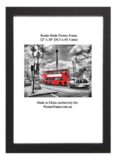For generations, Anglophone countries, such as Australia, used the imperial system of measurements which  included feet and inches. In picture framing, for photo frames and picture frames, inches were the most commonly used unit of measure. So picture frames were known, made and sold in sizes such as 8"x10" , 11"x14, 20"x30", etc. Beginning in 1970, Australia metrication gradually supplanted the imperial system and large scale conversion across the paper, printing, photographic and allied industries ... industries such as picture framing began.
included feet and inches. In picture framing, for photo frames and picture frames, inches were the most commonly used unit of measure. So picture frames were known, made and sold in sizes such as 8"x10" , 11"x14, 20"x30", etc. Beginning in 1970, Australia metrication gradually supplanted the imperial system and large scale conversion across the paper, printing, photographic and allied industries ... industries such as picture framing began.
There are many powerful reasons why Australia changed to the metric system but these are all embraced by the simple statement that it could not afford not to do so! This was the import of the 1968 Report of the Senate Select Committee on the Metric System of Weights and Measures when it unanimously concluded that the benefits of the change would greatly exceed the cost of conversion.
The main benefits stem from the simplicity of the system, the world-wide use of it and the opportunities the change provided for improvements in industrial and commercial practices. The adoption of the simpler, decimal, system of units saved time and gave more coherence to teaching in our schools and colleges and meant greater efficiency in operations involving weights and measures, particularly if they also involved monetary transactions.
Apart from the United States of America, there are now no countries of industrial significance which are not metric or committed to changing. The change improved Australia's trading position. Improved industrial and manufacturing efficiencies through the elimination of unnecessary variations in sizes and components resulted in economies in the costs of goods and services. This became particularly evident in the home building and allied industries.
Australia recognized the full benefits of this change. To work metric, play imperial, drink metric, eat imperial, teach metric and drive imperial was chaotic. Metric conversion thus proceeded in many different sectors of the community at the same time; in schools and technical colleges, in workshops, on the building site, on our playing fields and in our shops and stores. The decision that Australia made to change to the sole use of the metric system was not made lightly.
It almost occurred in 1901, the first year of Federation and has come under review from time to time since. Concomitant to this conversion was the adoption of the international ISO standard which comprises the A, B and C series sizes. Of theses, the "A series" is today the most used in picture framing and for many picture frame, poster frames and certificate frame sizes. These paper sizes are used all over the world because of the I.S.O. concept.
The concept is that of logical, mathematical and seamlessly proportional scaling. If a sheet or paper with a √ 2 aspect ration is folded in half along its shortest sides, then the two folded halves will also have a √2 aspect ratios. So, folded pamphlets of any given size may be constructed with the next larger size without spoiling aspect ratios. This is of great advantage in he printing, design, architectural fields and industries which use application programmes such as Adobe Illustrator which create scalable, vector-based, 2-dimensional and 3-dimensional modelling.
For example, if you were to make a vector-based (such as scalable lettering) advertising sign to suit an A0 (841x11189mm) and then asked to reduce it in size to an A5 (148x210mm) the output or printing quality of the smaller size would be unaffected and the same. Imagine advertising brochures that can be scaled and printed to by using sheets of the next larger size. So A4 sheets may then be folded and cut into A5 brochures.
The system allows scaling without degrading the aspect ratio as, for example, is done with photocopiers where it is common to enlarge A4 to A3 or to reduce A3 to A4. Another advantage of this system is that the weight of the paper being manufactured or printed is easy to calculate. If an A0 is 1 m2, its weight in grams is the same as its basis weight in grammes x square metres (g/m2). Thus a A4 sheet made from 160 g/m2 paper will weigh 10g, as it is one 16th (four halves) of an A0 sheet.
Therefore the weight, and its concomitant stamp price, is easily worked out by counting how many sheets are being mailed. For the actual, metric sizes, and of course, actual picture frames sizes, please refer to chart below:
 Thank you for reading this post "I'm from the U.S. and confused about the "A series" picture frame sizes, what are these?.
Thank you for reading this post "I'm from the U.S. and confused about the "A series" picture frame sizes, what are these?. 








J.H. I worked in Germany for several years and over there they use a lot of B series for photo frames and A series for picture frames. I find it strange that pretty much no picture framer sells B series frames for photos. I have to enlarge my photos to American inch sizes to frame anything. A nuisance.
The line "To work metric, play imperial, drink metric, eat imperial, teach metric and drive imperial was chaotic." really stood out for me. Imagine having a dual system of measuring! I grew up in the 70’s and lived through the changes and they were crazy and first but when we figured out how easy the metric system was, it all fell into place. I have always wondered about the A0, A4, A3 sizes and where they came from. This article explained it to me perfectly. It was interesting to note that an A4 sheet can folded into an A5 brochures.